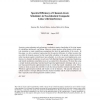Free Online Productivity Tools
i2Speak
i2Symbol
i2OCR
iTex2Img
iWeb2Print
iWeb2Shot
i2Type
iPdf2Split
iPdf2Merge
i2Bopomofo
i2Arabic
i2Style
i2Image
i2PDF
iLatex2Rtf
Sci2ools
ICC
2007
IEEE
2007
IEEE
Spectral Efficiency of Channel-Aware Schedulers in Non-Identical Composite Links with Interference
Accurate system planning and performance evaluation requires knowledge of the joint impact of scheduling, interference, and fading. However, current analyses either require costly numerical simulation or make simplifying assumptions that limit the applicability of the results. In this paper, we derive analytical expressions for the spectral efficiency of cellular systems that use either the channel-unaware but fair round robin scheduler or the greedy, channel-aware but unfair maximum signal to interference ratio scheduler. As is the case in real deployments, nonidentical co-channel interference at each user, both Rayleigh fading and lognormal shadowing, and limited modulation constellation sizes are accounted for in the analysis. We show that using a simple moment generating, function-based lognormal approximation technique and an accurate Gaussian-Q function approximation leads to results that match simulations well. These results are more accurate than erstwhile results that instead...
Cellular Systems | Communications | Electric Research Laboratories | ICC 2007 | Mitsubishi Electric Research |
| Added | 16 Aug 2010 |
| Updated | 16 Aug 2010 |
| Type | Conference |
| Year | 2007 |
| Where | ICC |
| Authors | Jingxian Wu, Neelesh B. Mehta, Andreas F. Molisch, Jin Zhang |
Comments (0)

